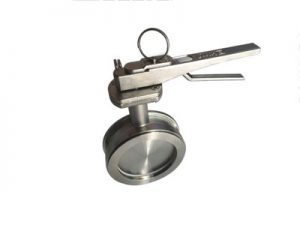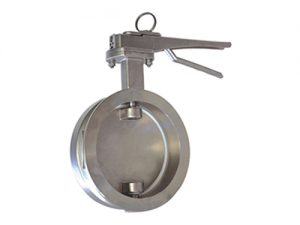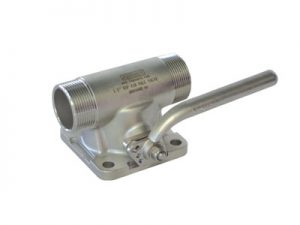Gasket is the main seal of flange connection, so the correct choice of gasket is also the key to ensure that flange connection does not leak. According to the different materials, gaskets can be divided into many kinds. In addition to the types of gaskets, the identification and selection of gaskets are also important!
Structural Types of Gaskets
Flat gaskets used in industry generally consist of sealing elements and inner and outer reinforcement rings. Sealing elements or gasket body is the key part to prevent leakage. The commonly used materials are non-metallic materials, such as flexible graphite, polytetrafluoroethylene (PTFE), fiber reinforced rubber-based composite board, etc. In addition, the sealing element material can also be rigid or flexible metal, usually used in high pressure and temperature occasions.
For sealing elements of non-metallic materials, metal materials are usually inserted to reinforce them, and it also facilitates the manufacturing and processing of sealing elements of fragile materials such as graphite. Reinforcement materials can be metal sheets or wire meshes. Metal sheets are often pierced to improve reinforcement and elasticity, and bonded together by binders and roll pressing. Sealing elements can also be provided with a surface layer or anti-bonding treatment layer to increase the sealing effect and prevent the flange sealing surface from bonding.
The outer reinforcement ring or the outer ring material are all solid metals, and their functions are as follows:
Help to align the sealing elements when they are installed.
Prevent excessive compression of sealing elements and damage; Prevent gasket blowing out and reduce flange rotation, etc.
The outer reinforcement ring is not in contact with the sealing medium, so it is not required to resist medium corrosion, so it is often made of carbon steel. The outer reinforcement ring can also be integrated with sealing elements, such as metal tooth gaskets and corrugated composite gaskets.
The material of the inner reinforcing ring or inner ring which contacts the fluid should be able to resist the corrosion of the sealing medium. The function of the inner reinforcement ring is:
Prevent the void between the sealing element and the flange of container or pipeline to avoid the void interfering with the flow of fluid and the resulting impact of fluid on gaskets.
Types of Flange Gaskets
1. Non-metallic Flat Gasket-PTFE Cladding Gasket
Introduction of gaskets
Polytetrafluoroethylene (PTFE) cladding gasket is a kind of non-metallic composite soft gasket, which is generally composed of encapsulation cover and insert. The envelope is mainly anti-corrosive, usually made of PTFE, and the insert (filler) is a non-metallic material with or without metal reinforcement, usually made of asbestos rubber sheet.
Polytetrafluoroethylene (PTFE) cladding gasket is mainly suitable for flange connections of all-plane and protruding steel pipes. It is suitable for corrosive media with nominal pressure PN of 0.6-5.0 MPa and working temperature of 0-150 degrees C or medium with high requirements for cleanliness.
(2) The form of gaskets
Polytetrafluoroethylene (PTFE) cladding gaskets for pipe flanges can be divided into three types according to their manufacturing methods: cutting type (S type), machined type (M type) and folding type (F type).
For machined cladding gaskets, the inner diameter of the cladding layer can be the same as the inner diameter of the flange, so as to prevent the eddy current of the fluid in the flange. For fold-wrapped crawler gasket, it is made of banded PTFE film with thickness of 0.4-0.8mm. The two ends of the gasket are heated and wrapped outside the annular core material in U shape by thermal sealing method. It is easy to manufacture and suitable for flange sealing with larger size.
(3) Label-Label Examples
Sectional PTFE gaskets with nominal diameter of 50mm and nominal pressure of 1.0MPa:
S-50-1.0 GB/T1304-1992
Machining PTFE gaskets with nominal diameter of 50mm and nominal pressure of 1.0MPa:
M-50-1.0 GB/T1304-1992
Folded PTFE gasket with nominal diameter of 50mm and nominal pressure of 1.0MPa:
F-50-1.0 GB/T1304-1992
2. Metal Composite Gaskets
(1) Metal wound gaskets
The metal winding gasket is a kind of semi-metal flat gasket, which is made of metal belt and non-metal belt spirally.
The characteristics of metal wound gaskets are as follows:
Good compression and resilience.
It has multi-channel sealing and certain self-tightening function.
It is not sensitive to the surface defect of flange pressing surface, does not bond flange sealing surface, and is easy to align, so it is convenient to disassemble.
It can partly eliminate the influence of pressure, temperature change and mechanical vibration.
It can keep its excellent sealing performance under various harsh conditions such as high temperature, low pressure, high vacuum, impact vibration and so on.
Form II
The winding gasket can be divided into four types according to its structure: basic type, inner ring type, ring type, inner ring type and ring type.
(3) Gasket type code (GB/T4622.1-2003)
(4) Label-Label Examples
With inner ring and ring type:
The ring material is low carbon steel and the metal strip material is 0Cr18Ni9.
The nominal diameter is 150 mm.
Nominal pressure 4.0 MPa (40bar);
Gasket Size Standard GB/T4622.2-2003;
It is marked as:
Winding pad D 1222-DN150-PN40 GB/T4622.2
Basic type:
The metal strip material is 0Cr18Ni9 and the filling strip material is flexible graphite.
The nominal diameter is 150 mm.
Nominal pressure 4.0 MPa (40bar);
Gasket Size Standard GB/T4622.2-2003;
It is marked as:
Winding pad A 0220-DN150-PN40 GB/T4622.2
Selection and use of winding gaskets:
A. Basic gaskets for mortise groove flange
B. Inner ring gaskets for concave and convex flanges
C. Ring gaskets for flat and protruding flanges
D, inner ring and ring gasket for flat and protruding flanges
(2) Metal cladding gasket
Structure
Metal cladding gasket is a kind of composite gasket, which is made of non-metallic material as core material, cut into required shape, and covered with metal sheet with thickness of 0.25-0.5mm. According to the state of cladding, it is generally divided into two types: plane type and corrugated type.
According to the structure type, it can be divided into plane type (F type) and corrugated type (C type). The structure of metal cladding gasket for pressure vessel flange is one of plane type.
(2) Standards and codes for sheet metal (JB/T4706-2000)
③标记—标记示例
Corrugated metal cladding gasket with nominal diameter of 50mm and nominal pressure of 2.0MPa: C-50-2.0GB/T15601
Marking and examples of metal cladding gaskets for pressure vessel flanges:
Cladding gasket with nominal diameter 1000mm,nominal pressure 2.50MPa and metal sheet 0Cr18Ni9:
Gasket G-1000-2.50-JB/T4706-2000
(3)Flexible Graphite Composite Gasket for Metal Punch Plate
Introduction of gaskets
This gasket,also known as flexible graphite metal reinforced composite gasket,is a kind of sealing gasket made of punched metal tooth plate or punched metal core plate and flexible graphite particles.It is usually made of flexible graphite composite reinforced plate.
According to the need,flexible graphite metal reinforced composite gaskets can be made into stainless steel or carbon steel inner or outer edges.
2.Characteristics
The main features are:good resistance to high,low temperature,corrosion,radiation and other properties,high strength,can be used under high pressure conditions.
The required pre-tightening force is smaller than that of using metal gaskets or metal wound gaskets.Because of the plasticity and good filling property of flexible graphite,the matching flange sealing surface does not need to be processed precisely when using this gasket,and the”water line”groove on the flange sealing surface can also be adapted,which is relatively economical.
Flexible graphite composite gaskets are divided into RF type,MFM type and TG type,which are suitable for flanges with protrusion,concave and convex surface and mortise and groove surface respectively.According to need,RF gasket can be wrapped with stainless steel or carbon steel,that is,RF-E type.
(3)Label-Label Examples
Flexible graphite metal reinforced composite gasket for mortise groove flange with nominal diameter of 100mm,nominal pressure of 2.5MPa and core material of low carbon steel:HG/T 20608 graphite composite gasket TG 100-2.5St
Inner-wrapped flexible graphite metal reinforced composite gasket for protruding flange with nominal diameter 200 mm,nominal pressure 4.0 MPa and core material 0Cr18Ni9:HG/T 20608 graphite composite gasket RF-E 200-4.0 304
(4)Metal corrugated composite gasket
Introduction of gaskets
The metal corrugated composite gasket made of flexible graphite is a kind of composite gasket covered with flexible graphite on both sides of the metal plate machined into corrugated shape.The gasket has the characteristics of both metal strength and corrugated elasticity.The temperature is 650 C,and the pressure can reach 26MPa.
(2)Gasket type
The flexible graphite metal corrugated composite gasket can be divided into three types according to its structure:basic type,positioning type and strip type.
Gasket Type Code(GB/T19066.1-2003)
(3) Marking-marking method
Ring type with positioning:
Metal skeleton material 0Cr18Ni9;
The nominal diameter is 150 mm.
Nominal pressure 4.0 MPa(40bar);
Gasket size standard GB/T19066.2.
Metal skeleton material code(GB/T19066.1-2003)
Wave tooth pad:
B3-DN150-PN40 GB/T19066.2
3.Metal gaskets
(1)Metal ring gasket
Metal ring gaskets are solid metal gaskets with octagonal or elliptical cross-section processed from metal materials,which have radial self-tight sealing effect.Therefore,the metal ring gasket is contacted with the inner and outer sides(mainly the outer side)of the flange ladder groove,and is sealed by pressing.
The octagonal annular cushion matches the flange groove,which mainly shows surface contact.Compared with the elliptical ring cushion,although it is not easy to close with the flange groove,it can be used again,and because the cross-section is linear,it is easy to process.The elliptical ring gasket is in line contact with the flange groove,which has good sealing performance,but requires high processing accuracy,thus increasing the manufacturing cost,and the elliptical ring gasket can not be reused.
The nominal pressure of metal ring gasket is 2.0-42.0 MPa.
(2)Metal toothed gaskets
Introduction of gaskets
The metal toothed gasket is a solid metal gasket.The cut surface of the gasket is serrated.The tooth spacing t=1.5-2 mm,the tooth height h=0.65-0.85 mm and the tooth top width C=0.2-0.3 mm.Turning several concentric circles on the sealing surface,the number of teeth is 7-16,depending on the size of gaskets.
(2)Structural forms and advantages of gaskets
There are four types of metal toothed gaskets:basic type,outer ring type,inner ring type and inner and outer ring type.The common structure is basic type.
Because the V-shaped bars in the contact area of the sealing surface of the metal toothed gaskets form many space line contacts with pressure difference,the sealing is reliable and the service life is long.Comparing with ordinary metal gaskets,this kind of gasket needs less pressure.
The disadvantage is that the sealing surface of two flanges is processed every time the gasket is replaced,which is time-consuming and laborious.In addition,the gasket is easy to leave indentation on the flange sealing surface after use,so it is generally used in less disassembled parts.The nominal pressure of metal toothed gasket is 1.6-25.0 MPa.
(3)Examples of markup
Metal toothed gaskets for concave and convex tube flanges with nominal diameter 100mm,nominal pressure 6.3MPa and material 0Cr19Ni9:toothed gaskets 100-630Cr19Ni9 JB/T88-1994
Selection of Gasket Size
1.Basic Principles of Choosing Gaskets
(1)When choosing or ordering gaskets,the following basic data should be known:
A.Sealing surface type and size of matching flange;
B.nominal diameter of flange and gasket;
C.nominal pressure of flange and gasket;
D.Temperature of fluid medium;
E.Properties of fluid medium.
(2)The following factors should also be taken into account when selecting gaskets:
A.It has good compression and resilience,and can adapt to the fluctuation of temperature and pressure.
B.It has good plasticity and can fit well with flange sealing surface.
C.For some metal flanges with stress corrosion cracking tendency(such as austenitic stainless acid-resistant steel),gasket materials should be guaranteed free of excessive impurities causing various corrosion,such as controlling the chloride ion content of gaskets to corrode flanges;
D.Non-polluting media;
E.For highly toxic chemicals,gaskets are required to have greater safety;for pipeline systems transporting flammable liquids,gaskets are required to be used on flanges at operating pressures and temperatures within limits;
F.It is not easy to harden at low temperature,shrinkage is small,it is not easy to soften at high temperature and has good creep resistance.
G.Good processing performance,easy installation and compaction;
H.Non-bonding flange sealing surface,easy to disassemble.
2.Selection of Standard Gaskets




